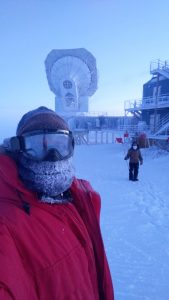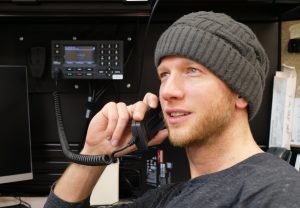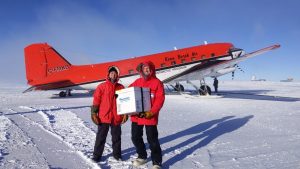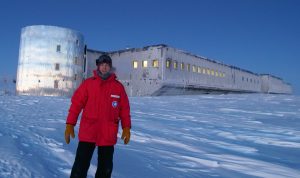Through Social Media PA Extends “Awe and Wonder” of Antarctica
Joe Horneman Uses Tik Tok to Educate About Daily Life and Science Education
December 8, 2021
By Hillel Kuttler
Josiah (Joe) Horneman, PA-C, 35, knows something about spending blocks of time in remote places. A PA in emergency medicine, Horneman worked for more than three years in a clinic on a Cherokee reservation in South Dakota. He’s also traveled for several months each in Guatemala, Vietnam, Iceland, Thailand, Easter Island, and the Galapagos.
On his YouTube channel, Horneman wrote that he enjoys “seeking out the rare and wondrous things on this planet.”
No kidding.

Now, this world traveler is concluding a nine-month stint working at a clinic in the most remote place on Earth, Antarctica. It’s a place that first intrigued Horneman as a child, when he noticed on his map the continent’s exhibiting no dots to indicate population.
Its isolation is such, Horneman explained in a mid-October video interview with AAPA, that he “freaked out” from a piece of lint, mistaking it for a bug or an insect, neither of which he’s seen since arriving at the South Pole region in February. That realization “is pretty nuts,” he said. So, too, are the rare occasions he spots dirt outside – living, as he and his 38 colleagues at the Amundsen-Scott South Pole Station do, atop 9,000 feet of snow and ice.
The station is one of three in Antarctica run by the United States to conduct scientific, climatic, environmental, and atmospheric research.
Social media allows for sharing life in Antarctica
Horneman’s captivation at the continent’s oddities and marvels is abundantly clear in the scores of YouTube videos and Instagram and TikTok posts he’s made since reaching Antarctica in February.
The posts show penguins and walruses gallivanting during Horneman’s first walk, spectacular auroras, British explorer Robert Scott’s hut that’s been intact since 1902, April’s last rays of sun before winter’s arrival heralded six months of darkness, Horneman blowing bubbles in the frozen air, an atmospheric mirage on the horizon known as fata morgana, the interior of the science station’s 350-ton telescope, Horneman knocking off from interior walls the ice formed by frozen breath, drapery covering windows to prevent artificial light from leaking into the complete darkness outside and thereby obscuring scientists’ view of auroras, and September’s “sun glow” preceding winter’s conclusion – his most-watched video, with 7.5 million views.
Horneman’s posts also have revealed Amundsen-Scott’s inner workings: the power plant, cafeteria, recreation room, weight room, gym, dormitory-style living quarters, and the cylindrical tower known as “the beer can” that leads to a tunnel feeding into a fuel depot, power plant, logistics center, and a maintenance facility for the station’s treaded vehicles.
Then there is his workspace. Viewers have glimpsed the medical clinic, dentistry suite, trauma bay, and radiology suite.
Horneman’s posts hold worldwide appeal. As of November 1, he has 1.1 million TikTok followers and garnered 11 million likes. Some posts, like his TikTok video of the South Pole’s once-a-year sunrise that drew his one-millionth follower on the social-media platform, are understandable. Others’ popularity are head-scratchers; more than 40,000 people viewed his clip of the trash-compacting system’s operations at minus-70 degrees Fahrenheit.
Wherever you want to go in your career, AAPA can help – join or renew your membership today.

Using TikTok to educate about science
“Educational content is not what you think of [regarding] TikTok,” he said of the platform better known for users’ posts of themselves singing and dancing, “but I’m trying to change that, one video at a time. I love showing daily life, but my passion is science education, to give people a sense of awe and wonder that this stuff exists. There are so many people [who] for one reason or another don’t ‘get’ science. I want to tell them: Everyone can at least grasp a little of it.”
Several teachers, including one in Australia, reported showing their classes Horneman’s video that explains the change of seasons, he said. Some students wrote to say that the videos enabled them to understand how Earth’s orbit and axis underlie Antarctica’s experiencing utter darkness and complete light six months at a time.
Their validation “makes me super-happy,” Horneman said. “I’m getting to be a teacher in a small way, and it’s super-gratifying.”
While his curiosity about the landscape and the station’s workings isn’t rare among staff who facilitate the work of Amundsen-Scott’s 10 scientists, Horneman stands out for his reach.
Sasha Rahlin, the chief scientist responsible for the station’s telescopes, said she’s facilitated Horneman’s trips to see the devices, approximately a 15-minute walk from the base. Many of those visits occur during his monthly inspections of the automated external defibrillators in each of the nearby outer buildings.
“He’s generally pretty impressed by the work we’ve been doing here. He’s done a good job of transferring that knowledge to the public in a way that’s interesting,” she said. “Science engagement fuels further research. There are all kinds of things we learn just by studying basic science.”
Vital as it is, science education isn’t Horneman’s purpose in Antarctica. Health-care provision is.

Providing healthcare to residents
He and physician, Ted Lee, M.D., see patients during office hours and are available around the clock. Predictably, they’ve treated many people for frostbite and colds – the South Pole set a frigidity record this year with an average winter temperature of minus-78 degrees Fahrenheit – along with bumps and broken toes. But they’re really there should major challenges arise, with surgery unfeasible except in dire circumstance and weather conditions preventing flights to evacuate patients to the nearest countries, Chile and New Zealand, most of the year. For that reason, all personnel must be in excellent health to qualify for Antarctica postings.
Thankfully, no medical emergencies or intensive treatment have occurred during Horneman’s South Pole tenure, leaving him and Lee ample time to prepare for and conduct weekly all-staff drills, practice CPR and intubations on mannequins, and create artificial veins to start faux IVs. The duo frequently challenge each other on handling heart attacks, strokes, and traumatic injuries. They’re often busy reading medical books and listening to medical-themed podcasts.
“Josiah and I have been a strong team,” Lee said. “He has the ability to connect with people here, and the breadth of his medical knowledge is very strong.”

Another physician, Chuck Huss, M.D., is perhaps most responsible for Horneman’s 2021 adventure. Horneman took Huss’s University of Iowa course on wilderness medicine when the former had an emergency-medicine fellowship at the school in 2017.
Huss’s tales of working at the South Pole in the early 1980s led Horneman to apply to do the same. After several attempts, he was selected a year ago.
“I feel honored to have inspired somebody to follow in my footsteps,” Huss said, adding that he’ll ask Horneman to address the class about his experiences.
That could be Horneman’s new calling. While still enjoying clinical work, particularly emergency medicine, Horneman said, he’s ready for a change.
“I’ve found that my real passion is science and travel,” he said. “The next thing might be education and showing people amazing things about the world.”
Editor’s Note: Joe Horneman returned to the U.S. from Antarctica in November 2021.
Hillel Kuttler is a writer/editor specializing in healthcare. He can be reached at [email protected].
You May Also Like
PAs in Wilderness Medicine
PA Student Proves Tenacity, Mental Balance Lead to Paralympic Gold
PA Soccer Referee Finds Work-Life Balance
How a Childhood in Bosnia Inspired This PA’s Career
Thank you for reading AAPA’s News Central
You have 2 articles left this month. Create a free account to read more stories, or become a member for more access to exclusive benefits! Already have an account? Log in.



